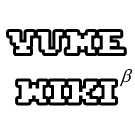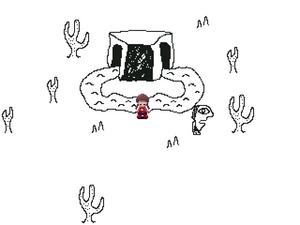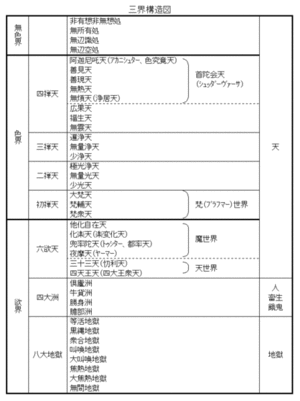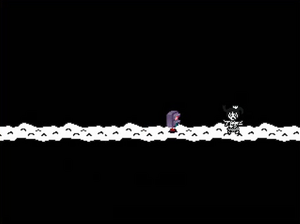White Desert (四つ)
And four(Yottsu), it is a discriminatory word against the Buraku
.
- 四つ足 -> 動物 -> 畜生、人間以下の意味。
- 動物の解体処理を業としていたから。
- 小指から士農工商と数えると、親指で穢多非人だから。
- 平民が5だとすると、人格的に何か1つ足りないから。
- 外部と通婚ができず狭い部落内での近親婚が重なり、指の欠損など奇形児が多発したから。
- 武器を持って蜂起しないよう、親指を切り落とされたから。
- Meaning Four-footed → Animal → preta, human below.
- Because it was on the business of slaughter of animals.
- Counting the hierarchy of samurai from the little finger, because multi-impurity is thumb.
- Assuming 5 is commoner, because missing one something personality.
- Consanguinity in the small village within the overlap through marriage and can not be external, birth defects, such as loss of fingers because frequently.
- So as not to uprising with a weapon, because I cut off the thumb.
※四つ(Word of "Yottsu" and Four finger gesture) is Ethnic slurs(差別語), Madotsuki that had been discrimination?
1970年代半ばから1980年代にかけて漫画雑誌を刊行している出版社がガイドラインを設け、5本指へ統一させている。 Publishing company that published a cartoon magazine 1980s since the mid-1970s provided the guidelines, thereby unified to five fingers.
それ以前に刊行、発行されているものは4本であったり5本であったりと一定ではなかった為であり、部落解放同盟等などの団体個人からクレームが相次ぎ、問題になっていた。
Those published earlier, has been issued is because it was not constant and a five or a four fingers, a claim after another from organizations individuals such as Buraku Liberation League, etc., and had become a problem.
※The entrance of the white desert, is the four fingers(四つ).
White Desert (Akanistha)
色究竟天(しきくきょうてん、Skt:Akanistha、音訳:阿迦尼咤天(あかにたてん)等他)は、仏教の世界観の1つであり、三界のうち、色界及び天上界における最高の天のこと。
色究竟天(Shi Kiku Kyo Ten、Skt:Akanistha、Transliteration:阿迦尼咤天(A Ka Ni Ta Ten)等他) is The heavens of the top, it is a part of Buddhism view of the world.
三界は上から無色界・色界・欲界の3つの世界があるが、色究竟天はその中の色界の最上位に位置する。
色界 (Form Realm) among 三界(Trailokya) 色究竟天(Akanistha) is located in the top of 色界(Form Realm) in it although 三界(Trailokya) has the three worlds of 無色界(Formless Realm)・色界(Form Realm)・欲界(Desire Realm) from a top.
※色究竟天 (Akanistha) is not 無色界(Formless Realm) and White Desert, And as the 色(color) description here.
「色」とは形体・物質のことで、色界は欲望から離れて清らかな物質や肉体が存在する世界であるが、
Although "色(Color)" is a form and a substance and it is the world where 色界(Form Realm) separates from a desire and a clean substance and flesh exist,
※無色界(Formless Realm) → "無色(No-color) 界(World)" → No-color world(White Desert?)
この天より上は肉体や物質が存在しない無色界になり、形体を有する天処の究る場所であるから、色究竟天と呼ばれる。
a heavens of the top becomes 無色界(Formless Realm) free of greed or matter where neither flesh nor a substance exists, and since it is a place which has described the heavens which have a form, it is called 色究竟天(Akanistha).
※White Desert is 無色界(Formless Realm),Because Monoko, Monoe, Dave is all shadowless(Formless?)
https://www.youtube.com/watch?v=MBZulTanQ98
漢訳の『法華経』序品で阿迦尼咤天=色究竟天と訳されている。
阿迦尼咤天(A Ka Ni Ta Ten) = 色究竟天(Akanistha) is Translation into Chinese from 『法華経(Buddhism Bible)』
サンスクリット語原典を日本語に訳す(漢文も同じ)と
the Sanskrit original text to Japanese from translating (Chinese writing is also the same)
「下はアヴィーチ(無間)地獄から、上はアカニシュタに至るまで」
"Until the bottom reaches 無間地獄(Hell) and a top reaches 色究竟天(Akanistha) "
※無間地獄(Hell) is Hell in Yumenikki?
Hell (Trailokya)
Trailokya (Skt., त्रैलोक्य trailokya; Pali, tiloka; Standard Tibetan: khams-gsum (Wylie)) has been translated as "three worlds,"[1][2][3][4][5] "three spheres,"[3] "three planes of existence,"[6] "three realms"[6] and "three regions."[4] These three worlds are identified in Hindu and early Buddhist texts, have counterparts in Brahmanical sources and are elaborated upon by more recent Theosophical theory.
In Buddhism, the three worlds refer the following karmic rebirth destinations:
- Kāmaloka:
world of desire, typified by base desires, populated by hell beings, preta, animals, ghosts, humans and lower demi-gods.
※無間地獄(hell beings) and preta(2 Hell(Preta)?) in Hell of Yumenikki.
- Rūpaloka:
world of form, predominately free of baser desires, populated by jhana-dwelling gods, possible rebirth destination for those well practiced in jhanic absorption. ※色究竟天 (Akanistha) is not 無色界(Formless Realm) and White Desert, Akanistha is located in the top of 色界(Form Realm).
- Arūpaloka:
world of formlessness, noncorporal realm populated with four heavens, possible rebirth destination for practitioners of the four formlessness stages.[3] ※White Desert is 無色界(Formless Realm),Because Monoko, Monoe, Dave is all shadowless(Formless?)
White Desert (Formless Realm)
The Formless Realm or Ārūpyadhātu (Sanskrit) or Arūpaloka (Pāli) (Tib: gzugs med pa'i khams) is a realm in Buddhist cosmology.[1]
It would have no place in a purely physical cosmology, as none of the beings inhabiting it has either shape or location; and correspondingly, the realm has no location either. This realm belongs to those devas who attained and remained in the Four Formless Absorptions (catuḥ-samāpatti) of the arūpadhyānas in a previous life, and now enjoy the fruits (vipāka) of the good karma from that accomplishment. Bodhisattvas, however, are never born in the Ārūpyadhātu even when they have attained the arūpadhyānas.
Monoe (空無辺処)
- 無色界の第1天。定を抑える一切の想を滅し、空間が無限大であると思惟する定。
Ākāśānantyāyatana or Ākāsānañcāyatana (Tib: nam mkha' mtha' yas) "Sphere of Infinite Space".
In this sphere formless beings dwell meditating upon space or extension (ākāśa) as infinitely pervasive.
Monoe (Hide-and-seek)
Hide-and-seek or hide-and-go-seek is a game in which a number of players conceal themselves in the environment, to be found by one or more seekers. The game is played by one player (designated as being "it") counting to a predetermined number while the other players hide. After reaching the number, the player who is "it" tries to find the other players. [1]
Monoe (Spirit away)
1 ルール (1 Japanese Hide-and-Seek Rule)
日本では近代まで神隠し・誘拐(人身売買)を恐れ、夕暮れ時以降はタブーであった[1]。
In Japan, disappearance and kidnapping (human trafficking) were feared till modernization, and it was a taboo after the time of twilight [1].
Dave Spector (Manhunt)
3 Variants 3.10 Team tag 3.10.2 Manhunt
Main article: Manhunt (urban game)
Manhunt is a mixture of hide and seek and tag, often played during the day. One person is it, while the other players have to hide. Then, the person who is it tries to find and tag them. The game is over when all players are out. Manhunt is sometimes played with teams. In one variant there is a home base in which a player is safe. That version ends when all players who are not safe are out.
Monoko (Statues (game))
Red light/Green light (sometimes abbreviated as RLGL) is a variation of statues. The "it" person stands at one end of the playing field, with the rest of the players at the other end. "It" turns their back to the others and calls out "Green light!" The players then run as fast as they can towards "it". At any time, "it" can face the players, calling out "Red light", and the others must freeze in place. If anyone fails to stop, they are out or must return to the starting line.
Big Red (Red Rover)
Red rover (also known as forcing the city gates and octopus tag) is an outdoor game played primarily by children on playgrounds. This 19th-century children's group game (requiring around 10 or more players total)[1] is thought to have originated in Britain and then spread to Australia, Canada and the United States.
Røver is a Norwegian word for "pirate", so perhaps the early British were showing bravery by daring the Viking raiders to "come over". The 1829 book titled The Red Rover: A Tale by James Fenimore Cooper describes the exploits of a pirate called "Red Rover".[2]
Big Red (Hana Ichi Monme)
Hana Ichi Monme (花一匁?) is a traditional Japanese children's game. The game is similar to the game Red Rover in the Western world. This game is often played in kindergartens and elementary schools.
Lyrics:
(1) Katte ureshii hana ichi monme
(2) Makete kuyashii hana ichi monme
(1) Ano ko ga hoshii
(2) Ano ko ja wakaran
(1) Sōdan shiyō
(2)Sō shiyō
Translation:
We're so happy we won, hana ichi monme
We're so upset we lost, hana ichi monme
We want that kid
We don't understand which kid you mean
Let's talk about it
Yes, let's
The children then huddle to choose a person from the opposing team and return back in line to call out...
※It seems that there is an opinion of having sung signs that he was bought for a human-trafficking contractor.
勝って:買って(won:buy)嬉しい花一匁 (子供が安く買えた。嬉しいねぇ)
He buys:wins it and it is delightful Flower;Child 1 匁;about 3.75g
(The child was able to buy it at a low price.I am glad.)
負けて:まけて(lost:price down)悔しい花一匁 (わが子が値切られてしまって悔しい)
It pricedown:loses and is mortifying Flower;Child 1 匁;about 3.75g (I am mortifying to bargain for my child)
A continuation of a song is also the same theory.









